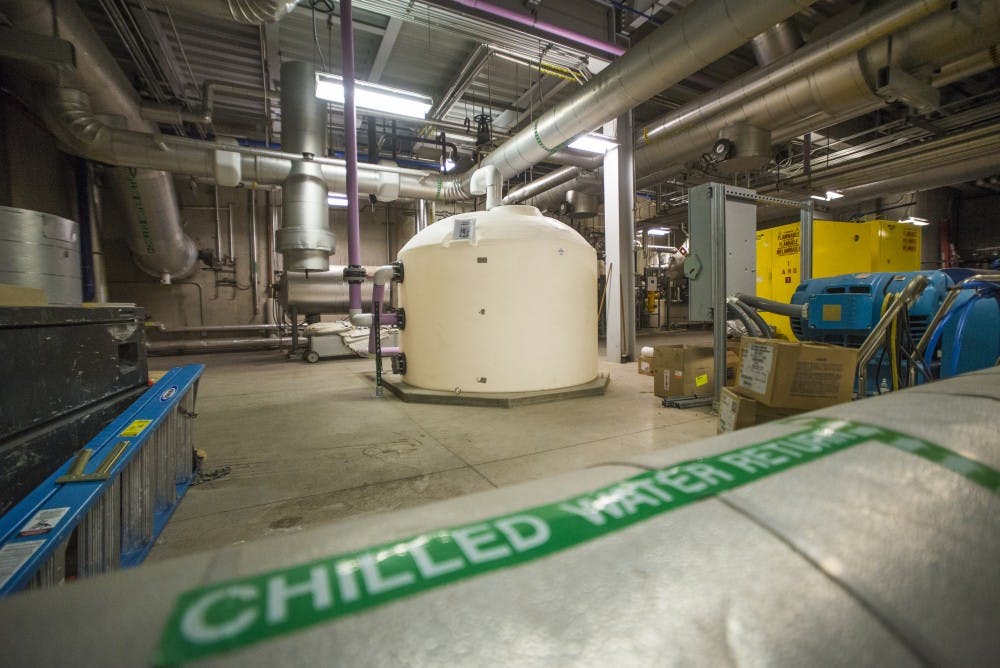With the upcoming legislative session, the state government is looking to make big cuts in higher education. Last year, the University of New Mexico tended to their carbon footprint by implementing multiple large-scale sustainability efforts and, for their efforts, PNM awarded UNM three Energy Star Awards to acknowledge efforts to decrease energy consumption across campus.
Here are a few of the efforts that resulted in UNM having received this recognition, as well as ongoing efforts for the future.
Water Conservation
A 4,700-foot pipeline was completed by UNM’s Physical Plant Department last summer, connecting the Lomas Chilled Water Plant directly to the UNM golf course. The pipeline catches “blow-down” water and is used for irrigation.
This project, driven by Bernalillo County and the North Campus Neighborhood Association, could potentially save up to 14 million gallons of water per year. As far as cost, it was funded from taxpayer money and state capital outlay funds, and totaled $500,000.
EV Charging Stations
Last June, UNM and PPD completed installation of two electric vehicle charging stations — located on the fourth level of the Cornell parking structure and the first level of the Yale parking structure.
No purchase of electricity is required, and the standard parking rates apply. Each station is able to attach to two vehicles at once, and the software allows for tracking usage over time.
David Penasa, manager in the PPD’s Engineering and Energy Services, applied for and received funds from the UNM Green Fund, whose goal is to promote and enable long-term sustainability measures to both the UNM infrastructure and education.
The cost of the project totaled $17,000, straight from the Green Fund, which is supported by student fees.
La Montanita Co-op Scholarship
The UNM Sustainability Studies program joined forces with La Montanita Co-op to offer a $1,000 scholarship to students minoring in Sustainability Studies in the Department of Biology.
Get content from The Daily Lobo delivered to your inbox
The scholarship opened to students last September, and according to program Director Bruce Milne, was matched through an existing endowment from the W.K. Kellogg Foundation.
Students must successfully complete 21 credit hours in the program. One course, “Communicating Community, Food, and Change: Lobo Gardens,” establishes and analyzes environmental contact, culture, sustainability and restorative change through cultivation and preservation of community food gardens.
South Lot lighting improvements
UNM’s South Lot received an expansive LED light project from the Physical Plant Department’s Engineering and Energy Services.
The initiative added new light poles, occupancy sensors, advanced controls for light conservation, and forward throw light distribution, which aims light away from residential homes.
The new system also allows for scheduling on/off times. Although all LED lights in the lot turn off automatically after midnight, movement will trigger the lights to briefly click back on.
Project manager and engineer for PPD Engineering and Energy Services, Angel Becerra, said this was a safety project since there were no lights on the outskirts of the lot and the existing fixtures were “inadequate.”
“By upgrading existing and adding new fixtures we were able deliver an even distribution of light in whole parking lot,” Becerra said. “The upgrades to this lot will hopefully make students feel safer at night when going to and from the bus stop.”
This project, spearheaded by the Associated Students of UNM, totaled about $180,000 and was funded by the state as a capital outlay project.
Physics and Astronomy Interdisciplinary Science building
Construction for the new Physics and Astronomy Interdisciplinary Science building will kick off this year. Last March, UNM selected Albuquerque-based Van H. Gilbert Architects to begin designs for PAIS.
PAIS, set to be a state-of-the-art high-research science facility, will replace the current Physics and Astronomy building located on North Campus, and must be certified by LEED — Leadership in Energy and Environmental Design.
Over a decade ago, then-New Mexico Governor Bill Richardson passed Executive Order 2006-001 aiming to implement methodical green building standards for state buildings. This bill also declares that any new state buildings over 15,000 square feet must be built with LEED certification.
LEED is a program of the U.S. Green Building Council that works to certify resource efficient buildings during any stage of development.
Christopher Carian — senior project/construction manager at UNM Planning, Design and Construction — said LEED is reshaping the way the population thinks about workplaces, homes and schools.
“LEED provides building owners and facilities managers with a framework for identifying and implementing practical and measurable green building design, construction, operations and maintenance solutions,” Carian said.
LEED offers different levels of certification in order to meet federal or state requirements and provide streamlining for multiple building projects.
In the scoring process, points are dispersed across five major credit categories: Sustainable Sites, Water Efficiency, Energy and Atmosphere, Materials and Resources, Indoor Environmental Quality, as well as an additional 6 points for Innovation in Design and an additional 4 points for Regional Priority.
PAIS must be designed and executed as LEED Silver certified, which needs 50-59 points.
Carian said LEED certification gives an independent, third-party verification to buildings designed and built to attain high operating capabilities in essential areas of human and environmental well-being.
“In order to get LEED certification a project has to go through a rigorous set of established, measurable and consistent practices or processes to meet what has been determined to be a sustainable building to prove that the project is lower on energy, water, and other natural resources than a traditional building,” Carian said. “This is good for the environment and does less harm to the planet.”
This project is funded by the 2014 and 2015 NM State Severance Tax Bonds, the 2016 NM State General Obligation Bonds, and the 2017 UNM Bonds, for a total of nearly $66 million.
Mary Clark, sustainability manager at the Physical Plant Department, said the facilities management staff in particular is always looking for ways to decrease energy usage, recycle and reuse materials, as well as reduce the use of carbon based fuels at UNM.
“UNM has always been an institution that uses the state’s resources in a responsible way and so it has been sustainable long before that term was made popular,” Clark said. “I sincerely hope our next president will support and encourage our sustainability efforts because that will make UNM more attractive to prospective students.”
Sarah Trujillo is a news reporter at the Daily Lobo. She can be reached at news@dailylobo.com or on Twitter @sarahtweetws_abq.






